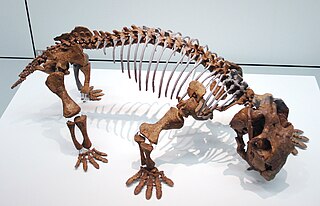The Guadalupian is the second and middle series/epoch of the Permian. The Guadalupian was preceded by the Cisuralian and followed by the Lopingian. It is named after the Guadalupe Mountains of New Mexico and Texas, and dates between 272.95 ± 0.5 – 259.1 ± 0.4 Mya. The series saw the rise of the therapsids, a minor extinction event called Olson's Extinction and a significant mass extinction called the end-Capitanian extinction event.

Anomodontia is an extinct group of non-mammalian therapsids from the Permian and Triassic periods. By far the most speciose group are the dicynodonts, a clade of beaked, tusked herbivores. Anomodonts were very diverse during the Middle Permian, including primitive forms like Anomocephalus and Patranomodon and groups like Venyukovioidea and Dromasauria. Dicynodonts became the most successful and abundant of all herbivores in the Late Permian, filling ecological niches ranging from large browsers down to small burrowers. Few dicynodont families survived the Permian–Triassic extinction event, but one lineage (Kannemeyeriiformes) evolved into large, stocky forms that became dominant terrestrial herbivores right until the Late Triassic, when changing conditions caused them to decline, finally going extinct during the Triassic-Jurassic extinction event.

Captorhinidae is an extinct family of primitive reptiles belonging to Eureptilia, known from the late Carboniferous to the Late Permian. They had a cosmopolitan distribution across Pangea.

Clyde Gilmour, was a Canadian broadcaster and print journalist, mostly known for his half-century career with CBC Radio.

Biseridens is an extinct genus of anomodont therapsid, and one of the most basal anomodont genera known. Originally known from a partial skull misidentified as an eotitanosuchian in 1997, another well-preserved skull was found in the Xidagou Formation, an outcropping in the Qilian Mountains of Gansu, China, in 2009 that clarified its relationships to anomodonts, such as the dicynodonts.

Raranimus is an extinct genus of therapsids of the Middle Permian. It was described in 2009 from a partial skull found in 1998 from the Dashankou locality of the Xidagou Formation, outcropping in the Qilian Mountains of Gansu, China. The genus is the most basal known member of the clade Therapsida, to which the later Mammalia belong.

Dromotectum is an extinct genus of bystrowianid reptiliomorph from the Late Permian of China and Early Triassic of Russia. Two species have been named: the type species D. spinosum and the species D. largum. D. spinosum, the first species to be named, comes from Lower Triassic deposits in the Samara Region of European Russia and is known from the holotype PIN 2424/23, which consists of armor scutes, and from PIN 2424/65, 4495/14 and 2252/397. It was found in the Staritskaya Formation of the Rybinskin Horizon and named by I.V. Novikov and M.A. Shishkin in 2000. The generic name means “corridor with hipped vault” + “roof” (tecton), and the specific name means “spinous”. A second species, D. largum, was named by Liu Jun, Xu Li, Jia Song-Hai, Pu Han-Yong, and Liu Xiao-Ling in 2014 from the Shangshihezi Formation near Jiyuan in Henan province, China on the basis of specimen IVPP V 4013.1, a large scute.

Gansurhinus is an extinct genus of moradisaurine captorhinid known from the Middle Permian Qingtoushan Formation of the Qilian Mountains and the Late Permian Naobaogou Formation in the Daqing Mountains of China. It was first named by Robert R. Reisz, Jun Liu, Jin-Ling Li and Johannes Müller in 2011 and the type species is Gansurhinus qingtoushanensis.

Chainosauria is a large clade of anomodont therapsids. It includes dicynodonts, dromasaurians and the basal taxon Patranomodon.
Shaanbeikannemeyeria is an extinct genus of dicynodont known from the Early Triassic of China. It contains a single species, S. xilougoensis, which was described in 1980 by Zheng-Wu Cheng from a skull catalogued as IGCAGS V315. The specimen was lost, and a neotype skull IVPP V 11674 was later designated. A second species, S. buergondia, was named by Jin-Lin Li in 1980 from a partial skeleton, but it has since been regarded as a synonym of S. xilougoensis.

Anakamacops is a genus of dissorophid temnospondyl from the early Middle Permian of China. It is known from the right side of a snout that was described in 1999 from the Dashankou locality of the Xidagou Formation, which is within the city of Yumen. The type species was named A. petrolicus because Yumen is an oil-producing city (petrol). More substantial material, including a partial skull and partial mandibles, was described by Liu (2018).

Sinophoneus is an extinct genus of carnivorous dinocephalian therapsid belonging to the family Anteosauridae. It lived 272 to 270 million years ago at the beginning of the Middle Permian in what is now the Gansu Province in northern China. It is known by a skull of an adult individual, as well as by many skulls of juvenile specimens. The latter were first considered as belonging to a different animal, named Stenocybus, before being reinterpreted as immature Sinophoneus. Sinophoneus shows a combination of characters present in other anteosaurs. Its bulbous profile snout and external nostrils located in front of the canine are reminiscent of the basal anteosaur Archaeosyodon, while its massive transerse pterygoids processes with enlarged distal ends are more similar to the more derived anteosaurs Anteosaurus and Titanophoneus. First phylogenetic analyzes identified Sinophoneus as the most basal Anteosaurinae. A more recent analysis positioned it outside the Anteosaurinae and Syodontinae subclades, and recovers it as the most basal Anteosauridae.

Cathaysia was a microcontinent or a group of terranes that rifted off Gondwana during the Late Paleozoic. They mostly correspond to modern territory of China, which were split into the North China and South China blocks.
Pectodens is an extinct genus of archosauromorph reptile which lived during the Middle Triassic in China. The type and only species of the genus is P. zhenyuensis, named by Chun Li and colleagues in 2017. It may be a member of the Protorosauria; an unusual combination of traits similar and dissimilar to other members causes Pectodens to elude exact classification.
Joan Marion Crockford-Beattie was an Australian geologist and palaeontologist who specialised in Permian bryozoan faunas.

The Junggar Basin is one of the largest sedimentary basins in Northwest China. It is located in Xinjiang, and enclosed by the Tarbagatai Mountains of Kazakhstan in the northwest, the Altai Mountains of Mongolia in the northeast, and the Heavenly Mountains in the south. The geology of Junggar Basin mainly consists of sedimentary rocks underlain by igneous and metamorphic basement rocks. The basement of the basin was largely formed during the development of the Pangea supercontinent during complex tectonic events from Precambrian to late Paleozoic time. The basin developed as a series of foreland basins – in other words, basins developing immediately in front of growing mountain ranges – from Permian time to the Quaternary period. The basin's preserved sedimentary records show that the climate during the Mesozoic era was marked by a transition from humid to arid conditions as monsoonal climatic effects waned. The Junggar basin is rich in geological resources due to effects of volcanism and sedimentary deposition.
The Naobaogou Formation is a geological formation in the Daqing Mountains of China. It is likely of Lopingian age. It consists of three rhythms of sediment, labelled members I-III primarily of purple siltstone, but each with a thick basal conglomerate bed. It is notable for its fossil content, producing one of the most diverse Late Permian vertebrate faunas outside Russia and South Africa.
Septopora is an extinct genus of bryozoan belonging to the order Fenestrida. It has been found in Pennsylvanian to Permian beds in North America, South America, Australia, and southwest and east Asia.
Tabulipora is an extinct genus of bryozoan belonging to the order Trepostomida. It has been found in beds of Permian age in North America, Spitzbergen, South America, and Asia. Specimens typically form cylindrical branching colonies.
Neoeridotrypella is an extinct genus of bryozoan of the family Eridotrypellidae, known from the Permian period. Its colonies were typically branching or tree-shaped though sometimes encrusting or massive, and the walls of its zooecial chambers were thicker within the exozone and full of tiny tubules.











